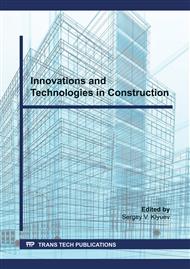[1]
V.K. Krylov, B.G. Bubnova, S.I. Vozny, V.V. Rabenau, Causes of contamination of markings made with thermoplastic materials, Construction materials. 2 (2010) 34-35.
Google Scholar
[2]
V.N. Sigaev, G.N. Atroschenko, V.I. Savinkov, P.D. Sarkisov, Pat. № 2505492 of the Russian Federation. A method of producing micro balls of yttrium-aluminosilicate glass for radiotherapy. (2014).
Google Scholar
[3]
V.M. Budov, L.S. Egorova, Glass micro balls. Application, properties, technology, Glass and ceramics. 7 (1993) 2-5.
Google Scholar
[4]
D.O. Bondarenko, V.V. Strokova, T.I. Timoshenko, I.V. Rozdolskaya, Plasma chemical modification of facing composite material based on hollow glass microspheres with protective and decorative coating, Perspective materials. 8 (2018) 72-80.
DOI: 10.1134/s2075113319020072
Google Scholar
[5]
D.O. Bondarenko, V.S. Bessmertny, V.V. Strokova, N.I. Bondarenko, Processes of formation of liquations, thermodiffusion and evaporation in facing composite material during plasmochemical modification, Bulletin of BSTU named after V.G. Shukhov. 7 (2018) 65-70.
DOI: 10.12737/article_5b4f02bd57c851.94144673
Google Scholar
[6]
V.I. Blagov, V.I. Ekaterinchuk, A.V. Benzen-Spiridonov, Installation for the production of glass micro balls, Glass and ceramics. 3 (1987) 15-16.
DOI: 10.1007/bf00697254
Google Scholar
[7]
A.V. Kosyakov, S.V. Nikulin, V.V. Budov, S.V. Kuligin, A.D. Ishkov, E.P. Salnikov, V.V. Rovovoy Pat. № 2672890 RF. Glass micro ball. (2018).
Google Scholar
[8]
A.V. Kosyakov, S.V. Kuligin, V.V. Rovovoy, E.P. Salnikov, D.V. Khomenko, V.I. Shubin, G.A. Levykh Pat. № 2602328 RF. Glass micro ball. (2013).
Google Scholar
[9]
V.S. Bessmertny, O.V. Puchka, D.O. Bondarenko, I.A. Antropova, L.L. Bragina Plasmochemical modification of wall building materials, Construction Materials and Products. 1 (2) (2018) 11 –18. https://doi.org/10.34031/2618-7183-2018-1-2-11-18.
DOI: 10.34031/2618-7183-2018-1-2-11-18
Google Scholar
[10]
A.A. Nikiforov, E.A. Maslov, N.K. Skripnikova, O.G. Volokitin, Teplofiz. Aeromekh. Investigation of the plasma technology for producing silicate refractory melts / 16 (1) (2009) 159-163.
DOI: 10.1007/s11510-009-0015-9
Google Scholar
[11]
M.A. Sheremet, A.A. Nikiforov, O.G. Volokitin, Complex for production of silicate melt from ash wastes, Glass Ceram. 64 (9-10) (2007) 322-325.
DOI: 10.1007/s10717-007-0082-8
Google Scholar
[12]
G.G. Volokitin, N.K. Skripnikova, Yu.A. Abzaev, [et al.], Investigation of the processes occurring during the plasma-chemical synthesis of high-temperature silicate melts. Part 1. Analysis of molybdenum ore dressing waste, Vest. TGASU. 4 (2013) 197-202.
Google Scholar
[13]
O.G. Volokitin, V.I. Vereshchagin, G.G. Volokitin, [et al.], Production of silicate melts with a high silicate module from quartz-feldspar-containing raw materials according to plasma technology, Izv. Vyssn. Uchebn. Zaved., Khim. Khim. Tekh. 57 (1) (2014) 73-77.
DOI: 10.6060/ivkkt.20226509.6535
Google Scholar
[14]
N.K. Skripnikova, V.I. Otmakhov, O.G. Volokitin, Processes occurring during plasma-chemical synthesis of refractory silicate materials, Glass Ceram. 67 (1-2) (2010) 19-21.
DOI: 10.1007/s10717-010-9221-8
Google Scholar
[15]
O.G. Volokitin, N.K. Skripnikova, G.G. Volokitin, [et al.], Mineral fiber, obtained in low-temperature plasma assemblies, from the products of burning coal and oil shale. Stroit. Mater. 11 (2013) 44-47.
Google Scholar
[16]
G.G. Volokitin, N.K. Skripnikova, O.G. Volokitin, S. Volland, Technology for producing mineral fibers by recycling ash-sludge and oil-shale wastes, Glass Ceram. 68 (7-8) (2011) 239-241.
DOI: 10.1007/s10717-011-9362-4
Google Scholar
[17]
V.P. Krokhin, V.S. Bessmertny, O.V. Puchka, V M. Nikiforov, Synthesis of aluminum yttrium glass and minerals, Glass and ceramics. 9 (1997) 6-7.
DOI: 10.1007/bf02782537
Google Scholar
[18]
V.S. Bessmertny, V.P. Krokhin, A.A. Lyashko, N.A. Drizhd, Zh.E. Shekhovtsova, Obtaining glass micro balls by plasma sputtering, Glass and ceramics. 8 (2001) 6-7.
DOI: 10.1023/a:1012882522621
Google Scholar
[19]
S. Rakotoarizon, Pat. № 2401811 RF Silica micro balls, manufacturing method, compounds and possible applications of silica micro balls. (2006).
Google Scholar
[20]
L.M. Demidenko, High-strength composite coatings. M.: Metallurgy, (1979) 216 p.
Google Scholar
[21]
F.B. Wurzel, V.F. Nazarov, Plasmochemical modification of the glass surface, Plasmochemical processes. Moscow: Nauka. (1979) 172-203.
Google Scholar
[22]
I.D. Tykachinsky, Design and synthesis of glass and ceramics with desired properties: scientific publication. M.: Stroyizdat. (1977) 145 p.
Google Scholar
[23]
N.A. Shaeffer Technology of glass. transl. from German. N.A. Shaeffer, K.H. Heusner; ed. N.I. Minko - Kishinev: CTI-Print, (1998) 280 p.
Google Scholar


